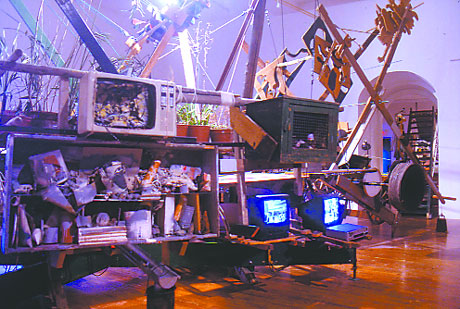Dieter Roth’s meticulously catalogued obsessions offer insights into mortality
Dieter Roth, the German artist whose phantasmagoric works include projects now on view at P.S. 1 in Queens as well as at the museum’s sister institution, MoMA Queens, was a hoarder, literally and metaphorically. Roth collected ephemera, constructed and re-constructed wooden sculptures and filmed every moment of his life for six months in the 1980s, among other ventures.
The results were “Flacher Abfall” (‘Flat Garbage”), a library of flattened trash that Roth collected from the streets and classified in 623 office binders; “Gartenskulptur” (“Garden Sculpture”), a veritable Noah’s Ark of planks, potted fronds, video monitors and soaring wooden parapets, a lower platform the station for Roth’s ink-tinted urine sealed in mason jars and carefully labeled; and “Solo Szenen” (“Solo Scenes”), an installation of 131 video monitors stacked on wooden shelves in a white room, not unlike the display showcase of an electronics store, until one spots the artist’s repeated image, naked before a sink, or hammering of piece a wood, or rustling beneath the covers as he sleeps—an endless and nearly solipsistic bombardment of details informing the quotidian, yet essential, tasks performed by a man clearly preoccupied with his mortality.
Redundancy, however, does not thrill Roth, not nearly as much as graphically depicting the decrepitude of forms and the regeneration that ensues—spontaneously and organically, or forced and coerced.
At the heart of “Gartenskulptur,” for instance, are the chocolate and birdseed busts of Roth that birds picked at and eventually consumed, but not until Roth began grafting all manner of material onto the wood where the birds alighted. That jungle gym, if you will (and its ladders and crevices invite climbing) has been transplanted, fastidiously, wondrously, into a former school cum museum in Queens, rejuvenation redux, to afford yet another perspective on a quintessentially German notion, popularized by Hegel—thesis, antithesis, then synthesis.
The ever-brassy P.S. 1 has dedicated the top floor to Roth’s sprawling, fascinating exploration of humans’ involvement with their surroundings. Even the floor planks of the artist’s former workshop/abode have been reconfigured as a wall installation, into which an opening has been cut, like a makeshift root cellar door, that invites entrance into archives of flattened artifacts.
Dieter died in 1998, yet this ark of a creation and all its anointed elements, from the artist’s work boots to a carpenter’s awl, keeps on circling the globe.

































